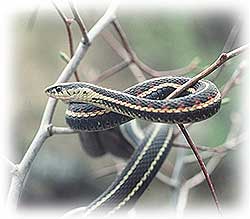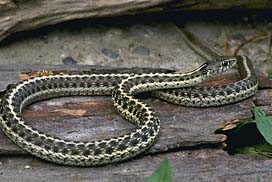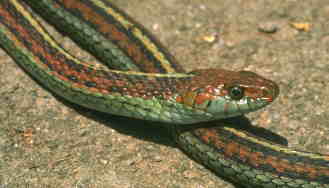
Melissa
Kaplan's
Herp Care Collection
Last updated
January 1, 2014
Not-So-Common Garters
©1994, 2002 Melissa Kaplan
What do brides, barbershop quartets and your garden have in common? Garters! While the former wear them on various limbs, the latter are beautiful, often colorful, delicate--and limbless--snakes.
Often mis-called "garden" or "gardener" snakes, garter snakes (Thamnophis spp)are found in a variety of habitats. So widespread are they that, either clutched in a grubby little hand or absentmindedly left in a pocket, they are usually the first snake a youngster springs on their mothers.
These members of the colubrid Natricinae subfamily gentle snakes rarely exceed three feet in length (T. gigas being one exception) and remain a slender two inches in girth. There are fifteen species in the United States, with 10 species (plus subspecies) occurring in the western U.S. Depending upon their species, they live between 3-10 years.
The name Thamnophis means "bush snake" and was originally applied only to ribbon snakes. Like their relatives the ribbon snakes, garters are found in a wide variety of habitats. The northernmost ranging of North American snakes, they can be found from the Yukon down to Costa Rica, and from the Pacific to the Atlantic coasts. In the more arid western states, they tend toward river valleys and other places where there are ready sources of water. Due to the inclination of humans to surround themselves with plants, often using copious amounts of water to keep the plants thriving, many garters have made their homes near human habitation.
Not all, however. One of the best known garter snakes is best known for all the wrong reasons. The San Francisco garter snake (T. sirtalis tetrataenia), arguably one of the most beautiful of all North American snakes, is endangered.
These delicately striped red, black, green and light blue snakes are found primarily in San Mateo county. Contrary to their common name, they ware never found (other than perhaps incidentally) in San Francisco due to the inhospitable habitats found there. While a few of these snakes have been found in Santa Cruz county, intensive research in the last two decades has found no reproductive populations in Santa Cruz. A subspecies of the common garter snake (T. sirtalis), the San Francisco's closest genetic and geographic relatives are the California red-sided garter snakes (T. s. infernalis) which are found in the coastal mountains north and south of the San Francisco peninsula.
The tetrataenia require a combination of thick, dense vegetation for cover interspersed with open areas needed for basking. They need to stay close to water in order to meet their dietary needs which are provided by a diet which is primarily frogs. Marshlands, riparian brush, ponds, fresh water sloughs, reservoirs, creeks, estuaries and the meadows bordering these areas provide the right amount of cover, basking areas and provisions (these garters also eat tadpoles; only about five percent of their diet comes from meadow mice and fish).
Like many snakes, the tetrataenia are quick to bolt for cover when disturbed. Despite their vivid coloring, they "disappear" in the brush, their outline "disrupted" by the different colored stripes. Anyone who has released a garter into dense bush knows how rapidly they seem to fade into the background--while still in plain sight. These diurnal snakes are active most of the year, but are perhaps most easily seen during the spring months. During this time, they feed heavily on tree frogs (Hyla regilla), the native red-legged frogs (Rana aurora) and the introduced bullfrogs (R. catesbeiana). The garters disperse into the meadowlands, congregating at the bodies of water again in mid-summer to take advantage of all the metamorphosing tadpoles. During the latter part of the summer, many of the creeks and ponds dry up at which time the garters take off for the meadows again.
Reproducing tetrataenia require a diet consisting primarily of frogs (juveniles may also feed on salamanders, earthworms and treefrogs). Thus, despite an abundance of mice and fish, where there are no frogs, there are no tetrataenia.
And herein lies the problem. With the destruction of habitat, due to construction of human habitation and commercial and industrial development, and due to the pollution of fresh water sources from agricultural runoff and leaching of industrial wastes, the frog populations are in decline and suitable vegetated areas are rapidly disappearing. Feral and otherwise adventurous house cats have also become significant predators of these garters.
Natural predators include the red-tailed hawk, the great blue heron, the common king snake (Lampropeltis getula californiae), yellow-bellied racer (Coluber constrictor mormon) and the largemouth bass; the long-tailed weasel may also be a significant predator. These predators evolved with the San Francisco garter and an equilibrium in populations was in place long before the human variable entered the survival equation.
Sixty-five "permanent" reproductive populations have been found on the Peninsula. Ranging in size from two to over 500 hundred adults (depending upon the amount of cover and prey), the total population of this species is believed to number only 1500 adults. Young under one year of age are excluded; the total population increases every summer when the young are born (garters are viviparous, bearing live young), but declines to 1500 again by the following spring due to lack of food, appropriate habitat, and introduced predation.
Some individual garters of reproductive age may be found at other ponds, wandering from suitable habitat to habitat, but without the necessary frog populations reproductive groups are unable to "colonize" these areas. Come spring, these wandering garters are generally back at their usual ponds.
The only natural habitat left in which these snakes can be found are vernal pools (seasonal ponds formed along seismic fault lines), brush-lined creeks and coastal estuaries. Approximately 30% of the potentially suitable "artificial" habitats--farm ponds, irrigation canals or artificially channeled sloughs and reservoir impoundments--are home to about 70% of all tetrataenia; this limited area of occupation is probably due to the lack of proper cover, absence of adjacent meadowlands and frog populations which are limited or non-existent.
From Widespread to
Endangered in 20 Years....
In the 1940's,
UC Berkeley graduate student Wade Fox surveyed the tetrataenia
populations and found several hundreds of these garters in sag ponds south
of the San Francisco County line along Skyline Boulevard. Located on hog
farms and alongside road embankments on the San Andreas Fault near Pacifica,
Daly City, San Bruno and South San Francisco, these ponds were known as
the "Skyline Ponds." The abundance of tetrataenia coincided
with the abundance of red-legged frogs found in these ponds and the extensive
cover around the ponds.
Revisiting the ponds during the 1950's, Fox found that some of the ponds had been drained and filled, turned into extensive housing developments. By the early 1960's, nearly all of Skyline Boulevard north of the watershed had been developed. Herpetologists became concerned about the future of the tetrataenia. As Fox had not surveyed other possible habitats on the Peninsula, it was unknown whether the garters existed in any of these areas in reproductive populations. As the rural Peninsula was quickly becoming urban and suburbanized, it became imperative to protect existing populations until the full extent of the range of the species could be identified.
In 1966, the U.S. Fish and Wildlife Service (then called the U.S. Bureau of Sport Fisheries and Wildlife) included the San Francisco garter snake on its first list of rare and endangered species. In 1968, the International Union for the Conservation of Nature (IUCN) listed the San Francisco garter as "critically endangered." It was not until 1970, however, that the California legislature extended protection to this species, enacting legislation to protect it from overcollection by the pet trade. At this time, the snake appeared on the first (and then on all subsequent) California Department of Fish and Game lists of endangered California species. It was not until the federal Endangered Species Act of 1973 that the species was protected from habitat destruction due to human development (which should not be construed as meaning that development stopped; to the contrary, it continued--and continues--to put this and other threatened and endangered species at risk). A 1985 recovery plan published by the U.S. Fish and Wildlife Service stressed the need for acquisition of habitat and species protection. To be able to fulfill the mandates, however, more information about the species and its habitat was needed. For many years, researchers at U.C. Davis studied these garters, studying their distribution throughout their habitats, their natural history and reproductive success. These studies confirmed that the Skyline population had been completely wiped out. A tiny, isolated population was found on San Bruno Mountain, but it too died out due to the destruction of habitat.
As with most other species under threat of extinction, the San Francisco garters' biggest threats come from humans: urban and industrial development, destructive habitat management, land-waterway use and management, reservoir levels, overgrazing of meadowlands and trampling of essential vegetation by cattle and pet trade collection. In the last twenty years especially, the populations in Pacifica near Point Ano Nuevo, along the bayshore and on the watershed have been adversely affected by freeway, housing and other urban expansion projects. Habitat that is ideal for these snakes--flat or gently sloping meadowland--is also eagerly sought by property developers. The most economical use of water is not necessarily best for the tadpoles; fluctuations in watershed and reservoirs cause massive die-offs of this essential garter food source.
The San Francisco garter is still a protected species. But until changes are made in water and land use and management patterns, the remaining populations and their food sources will not survive.
Under Section 40.10 of the California Department of Fish and Game's California Sport Fishing Regulations (as amended effective March 1, 1994), it is illegal (except by special permit) to take or possess the San Francisco Garter snake [T. s. tetrataenia], the Giant Garter snake [T. gigas] and the Two-striped Garter snake [T. hammondii].
Sources
Tideline, 13(4). U.S. Fish and Wildlife Service. 4p.
Garter Snakes and Ribbon Snakes: Care in captivity. Northern Nevada Herpetological Society, February 22, 1994. 2p
Sweeney, Roger. (1992) Garter Snakes: Their natural history and care in captivity. London: Blandford. 128p
Stebbins, Robert C. (1985) Western Reptiles and Amphibians. Boston: Houghton Mifflin Company. 336p
Conant, Roger and Collins, Joseph T. (1991) Reptiles and Amphibians: Eastern/Central North America. Boston: Houghton Mifflin Company. 450p
Sean Barry (Rowe Program in Genetics, University of California, Davis), who wrote the article in Tideline, will be soon be publishing several new articles and a monograph on the San Francisco garters.
Common Names - Uncommon
Looks
I get a number
of calls and letters from people all over Northern California who insist
they have a San Francisco garter in their yard. This should help clear
things up...
|
|
 Red-Sided Garter T. s. parietalis From Manitoba Wildlife & Ecosystem |
|
|
 Santa Cruz Garter T. atratus From Alan Francis' Collection |
 Western Terrestrial Garter T. elegans Alan Blake Sheldon, Enature.com |
Thamnophis
Species List
From the TIGR Reptile Database
| T. angustirostris
T. atratus T. brachystoma T. butleri T. chrysocephalus T. couchii T. cyrtopsis T. elegans T. eques T. exsul T. fulvus T. gigas T. godmani T. hammondii |
T. marcianus
T. melanogaster T. mendax T. ordinoides T. proximus T. radix T. rossmani T. rufipunctatus T. sauritus T. scalaris T. scaliger T. sirtalis T. sumichrasti T. valida |
Subspecies for Thamnophis Pictured Above (Links to TIGR Database)
T. atratus
Subspecies
T. a. atratus (KENNICOTT, 1860) Santa Cruz Garter Snake
T. a. hydrophilus FITCH, 1936 Oregon Garter Snake
T. atratus zaxanthus BOUNDY 1999
T. elegans Subspecies:
T. e. arizonae TANNER & LOWE 1989 Arizona Garter Snake
T. e. elegans (BAIRD & GIRARD 1853) Mountain Garter Snake
T. e. errans SMITH 1942 Mexican Wandering Garter Snake
T. e. terrestris FOX 1951 Coast Garter Snake
T. e. vagrans (BAIRD & GIRARD 1853) Wandering Garter Snake
T. e. vascotanneri TANNER & LOWE 1989 Upper Basin Garter Snake
T. e. hueyi (VAN DENBURGH & SLEVIN 1923)
T. sirtalis Subspecies:
T. s. annectens BROWN, 1950 Texas Garter Snake
T. s. concinnus (HALLOWELL, 1852) Red-spotted Garter Snake
T. s. dorsalis (BAIRD & GIRARD, 1853) New Mexico Garter Snake
T. s. fitchi FOX, 1951 Valley Garter Snake
T. s. infernalis (BLAINVILLE, 1835) California Red-sided Garter
Snake
T. s. lowei TANNER 1988
T. s. pallidulus ALLEN, 1899 Maritime Garter Snake
T. s. parietalis (SAY, 1823) Red-sided Garter Snake
T. s. pickeringii (BAIRD & GIRARD, 1853) Puget Sound Garter
Snake
T. s. similis ROSSMAN, 1965 Bluestripe Garter Snake
T. s. sirtalis (LINNAEUS, 1758) Eastern Garter Snake
T. s. semifasciatus
T. s. tetrataenia (fide STEBBINS 1985: 200) San Francisco Garter
Snake
Related Articles
Don Roberson's San Francisco Garters
California Fish & Game's Threatened & Endangered Species: Reptiles & Amphibians

